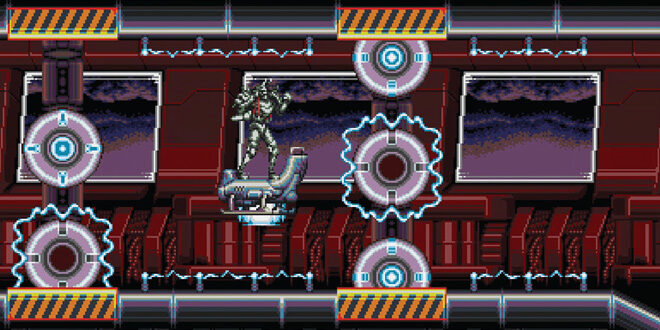 Game designer and artist Danilo Dias spoke to Vince Pavey about JoyMasher’s Vengeful Guardian: Moonrider, a retro style action adventure game about a robot rejecting the oppressive programming of its society and going on a hardcore quest for justice.
Game designer and artist Danilo Dias spoke to Vince Pavey about JoyMasher’s Vengeful Guardian: Moonrider, a retro style action adventure game about a robot rejecting the oppressive programming of its society and going on a hardcore quest for justice.
Vengeful Guardian: Moonrider is a fast paced precision action platform game from studio JoyMasher. Its gameplay is loosely inspired by absolute classics like Capcom’s Mega Man X3 and SEGA’s Shinobi, and its visual style has taken on a healthy dash of inspiration from the Super Nintendo hidden gem Hagane for good measure.
JoyMasher has brought appreciative gamers retro-inspired hits like Oniken, Odallus and Blazing Chrome since it was founded in 2012. Its games have painted a picture of a small but tenacious studio from Brazil that appreciates the legacy of the industry and isn’t entirely comfortable with sitting still and doing the same thing for multiple games in a row.
After two games in the 8-bit NES-style, and one that instead went for the 16-bit Mega Drive look, the studio could’ve gone in any direction it wanted. What actually happened next came down to a mix of an artist recognising and furthering their own self-improvement, an adoration for a particular style of video game art, and a little bit of sacrifice – and as for what led them to doing another 16-bit Mega Drive style game, well …
“I think I got better at pixel art!” laughs Danilo Dias, the game designer and artist on all of JoyMasher’s projects. “I was very confident about my work as an 8-bit style pixel artist, but I wanted more. When we made the jump to our previous game Blazing Chrome, I wanted to try something more detailed, with more texture and huge machines. I still used limitations on colours and resolution, however. I feel the limitations help me a lot to be a better artist overall. When doing the art for Moonrider, I decided to tone down the backgrounds compared to Blazing Chrome, but make bigger characters with more animation frames. I often have to make sacrifices to work with pixel art, since I’m the only artist. That’s why I make these decisions. They are both stylish and practical!”
WELCOME TO THE NEXT LEVEL
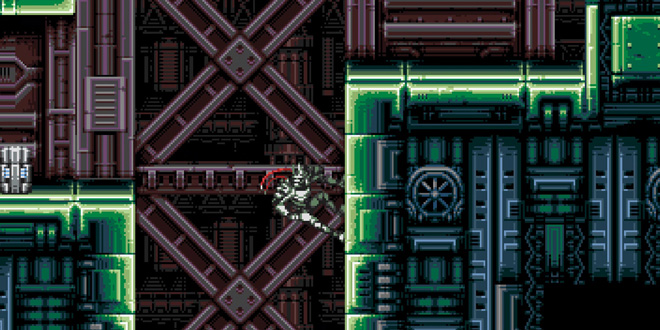
There’s an undeniable Mega Drive (or Genesis, if you’re reading this in the United States) influence on the look, feel and sound of the Vengeful Guardian: Moonrider experience, and it turns out that comes down to largely the same mix of factors that made the SEGA console option the ‘cooler’ one than the Super Nintendo to grungy teenagers back in the 1990s. Well, everything but the blue hedgehog.
“To me, the Mega Drive has the perfect 16-bit look.” explains Dias. “The palette limitations and number of colours makes most Mega Drive games look grunge and badass. I think that looks awesome on a cyberpunk ninja game. It’s high contrast and has a big emphasis on texture.”
When it came to deciding on which retro design elements to bring forward, and which to leave in the past, for JoyMasher it was just a matter of making it fun and not trying to fix things that aren’t broken.
“I always try to bring in the good stuff that worked perfectly then and still works great nowadays,” says Dias. “I like making it challenging without it being frustrating. Fast combat. Vehicle sections. Patterns in bosses’ attacks. I think those things are very important to our games. The endless pits that instantly kill you? I left those in the past!”
Games from the 8-bit and 16-bit era of consoles would often take on entirely different styles and perspectives based on levels and their context. These shifts were often to showcase a unique console hardware or cartridge feature like sprite scaling, or show off fancy 3D polygons that would wow players and critics alike.
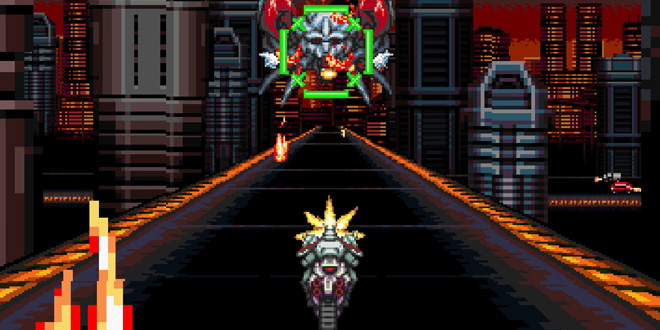
JoyMasher is no stranger to trying to emulate the design hallmarks of times past, so we weren’t surprised to see superscalar arcade game style motorbike sections in Moonrider. They’re not only some of the game’s best moments, but honestly made us feel a bit like the critic from the film Ratatouille – except this time the flashback was to a wee ginger lad with curly-ish hair playing EA’s Road Rash in a very 90s jumper. What may surprise you is that they were added to the development plan later, as response to positive feedback received by the developer.
“At first the idea was to just make side-scrolling bike sections, but after the good feedback from players about the superscalar section in Blazing Chrome, we decided that Moonrider should have one of those too,” notes Dias. “It was mainly Andre’s idea and I loved it. We even brought back Iuri Nery, the programmer of Blazing Chrome, just to write the code of those sections.”
Designing those sections differed from designing the retro 2D action the studio is well known for, as you’d expect. Especially as the challenges included having to abandon their more familiar methods.
“The faux-3D action sections were a huge challenge, because a ‘level editor’ tool for those sections just doesn’t exist.” remembers Dias. “Basically, we had to design all those sections as code, and then replay the level multiple times to see if everything was working, if the pace was good, if the number of enemies was right, or whatever. It was a nightmare!”
ISHINOMORI HEROES
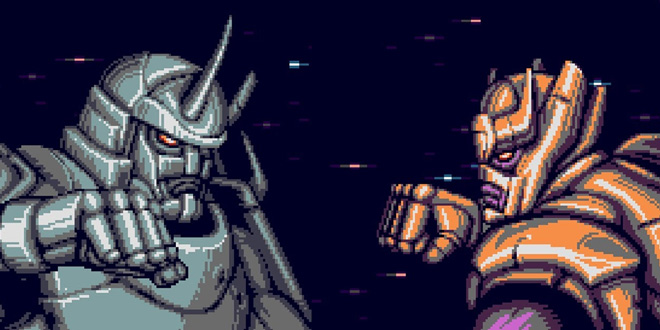
While its retro game inspirations are perhaps more obvious, Moonrider also leans on tokusatsu special effects drama influences, with its title, lead character, story and even the core gameplay moveset making heavy nods towards Shotaro Ishinomori’s 1971 Japanese TV-series Kamen Rider and subsequent spin-offs like the 1987 show Kamen Rider Black.
“Kamen Rider Black was my favourite superhero when I was a kid,” Dias tells us enthusiastically. “Tokusatsu was a huge thing here in Brazil during the 80s and early 90s, thanks to imports of many of the shows from Japan. Another influence on the game was the film Mechanical Violator Hakaider.”
There is even one part of the game that makes use of a trope well-worn in both tokusatsu and video games, with a homage to the rivalry and battles between the previously mentioned Kamen Rider Black and his ‘equal but opposite’ brother, the brain-washed villain Shadow Moon.
“We included a classic fight with ‘your equal or twin unit’ in the game, just like in Kamen Rider Black,” explains Dias. “If you look closely, the capsule that Moonrider was sleeping in was marked ‘’02”. It’s set up early on.”
TO BE THIS GOOD TAKES AGES
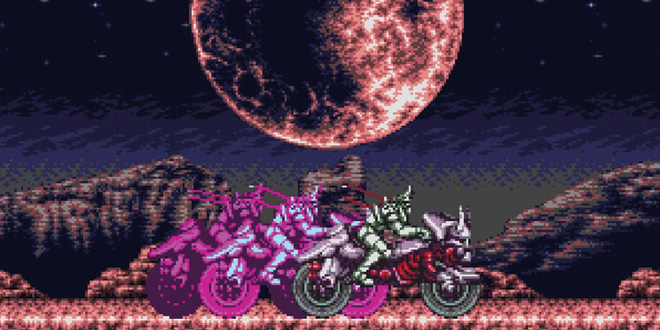
Vengeful Guardian: Moonrider was also developed in a different engine to previous JoyMasher titles, largely because Dias started work on the game as an endeavour to learn a new piece of development software.
“We used Construct 2 to create Moonrider. At first, I was working on it alone as a project on the side while working on Blazing Chrome with Luri Nery, because I wanted to learn Construct 2.” explains Dias. “Later on, it became our next big thing, so André Chagas came on board to be the programmer. He suffered a lot, dealing with my code … Poor guy!”
Thanks to its somewhat nebulous origins and subsequent push into the studio spotlight, Moonrider went through a bumpy phase in its early development, the experience of which reaffirmed for Dias just how crucial planning your project and making sure things actually work before you get too far actually is.
“The lesson I learned is to never try to change the core game design of the game in the middle of production,” winces Dias. “Moonrider was originally supposed to have a structure closer to Konami’s Castlevania: Dracula X in style. It was going to have alternate routes during some stages, and wouldn’t have had power chips or the same special weapons. About a third of the way into development we realised it wasn’t working, so we had to change things. I already knew that was not an ideal practice, but it was necessary to improve the experience for our players. Next time I’ll try harder to have everything planned from the beginning!”
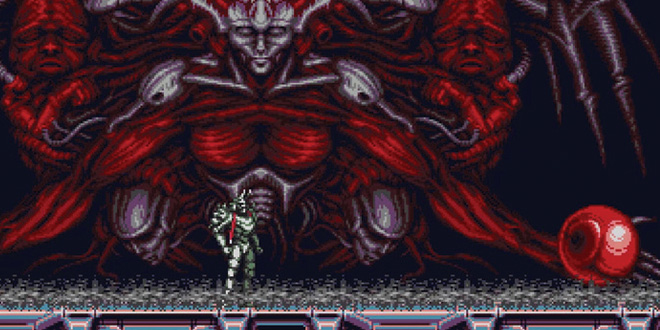
It didn’t help that a pandemic happened in the middle of development, either. “One of the biggest issues we had was the pandemic,” explains Dias. “It affected our development work, because we couldn’t see people playing the game at events, or even see friends playing it. It was very problematic to the way we work, because you can’t judge the level design correctly all by yourself. You need to see people playing your game to be able to make everything smooth enough.”
It might sound obvious when you think about it, but should you be a developer that aspires to making retro style games like JoyMasher, Dias believes that being very familiar with both the experiences, technology and history of classic video games is the best and most important place to start. With that foundation in place, it all comes down to insight and personal taste as you take your place on the shoulders of giants.
“I think it is to know and play lots of retro games, even the ones you don’t like. Having references is an amazing tool. With experience of playing a lot of those old games, you know what worked and what didn’t work. You also can see what type of graphics you want, and there are art references and everything.”
Otherwise, the best piece of advice Dias has for aspiring indie game developers, is to keep your eye on the scope, budget and development time of your game project, to recognise your constraints, and achieve the things that you know you can actually do. “Never try to make something too big. Try to stick with things you’re sure you can do comfortably. Things that you know you are capable of. It’s better to have a humble, really well-made game than a giant mess.”
As for what’s next for JoyMasher? They’re still working that part out. “This time I really don’t know. It’s so weird! I felt like that after Odallus,” remembers Dias. “I had no idea what we’re going to do. I’m studying 3D graphics now, so maybe something with low poly graphics?”

 MCV/DEVELOP News, events, research and jobs from the games industry
MCV/DEVELOP News, events, research and jobs from the games industry
